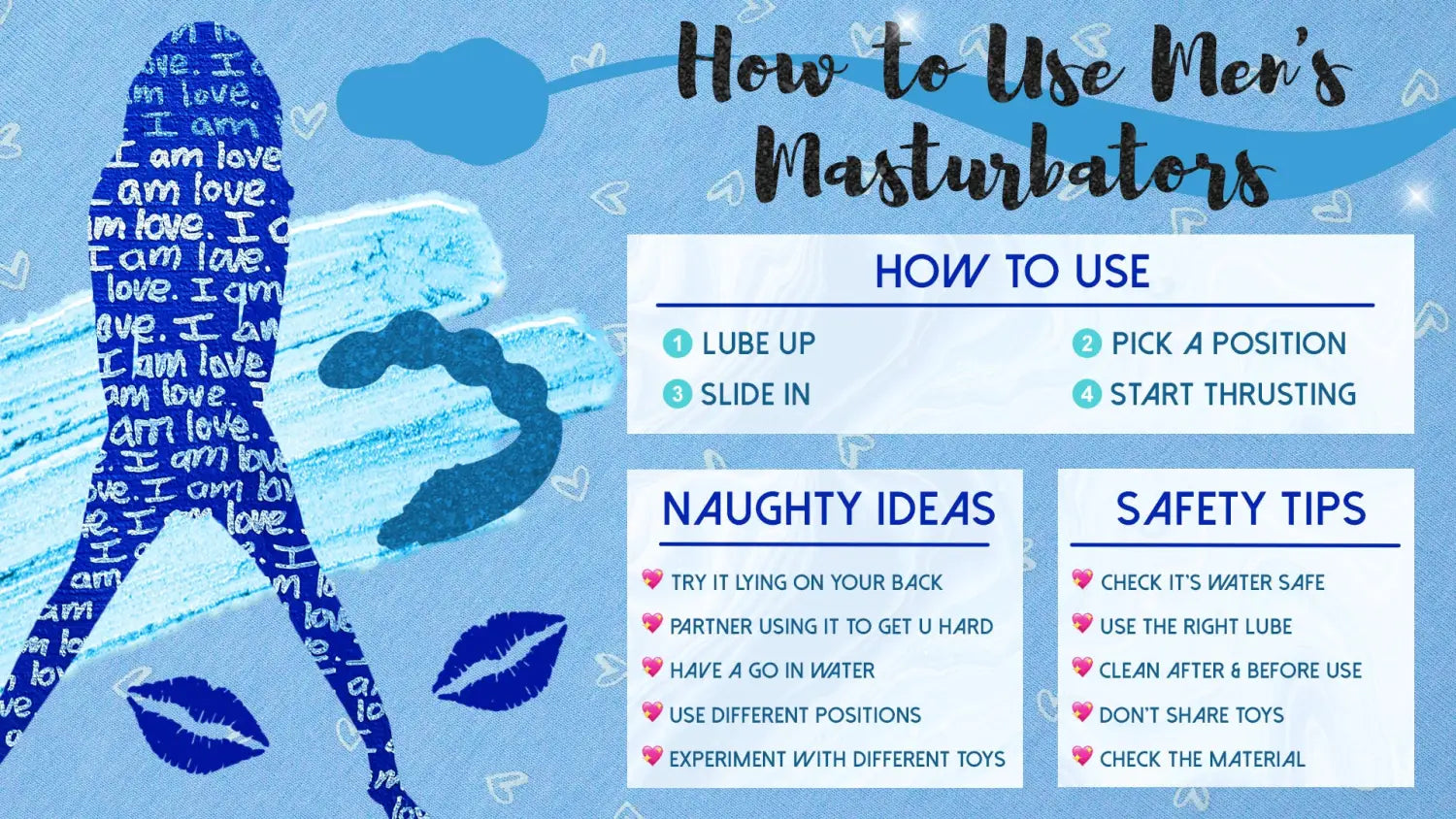
How to Make a Male Masturbator: Craft Your Own Unique Pleasure Toy
Content Verification



✨ Whiz-Bang Takeaways✨
🛠️ DIY pleasure at its finest—build your very own male masturbator.
🧼 Hygiene first! Keep your creation clean for maximum enjoyment.
💡 Experiment with materials for a truly bespoke experience.
🕵️♂️ Top-secret crafting? No worries, everything stays discreet.
💡 Pro Tips and Cheeky Tricks 💡
🧴 Always use a generous dollop of lube for a smooth ride.
🔥 Want a warmer feel? Preheat your materials (safely, of course!).
🌍 Get creative! Household items can lead to unexpected delights.
🛡️ Safety first: Avoid materials that could cause irritation or damage.
Ever thought about making your own male masturbator? You’re not alone! DIY sex toys are becoming more popular, and for good reason. Why settle for generic when you can create a custom toy that’s tailored just for you? Imagine designing a masturbator that fits your exact needs—whether it’s the perfect texture, size, or feel. Not only is it cost-effective, but it also lets you get creative and explore your own pleasure in a whole new way.
Plus, let’s face it—buying a male masturbator can be expensive, and sometimes, the ones on offer just don’t cut it. By choosing to create your own male masturbator, you’re taking control of your experience, making it as unique as you are.
Ready to dive in and build a custom pleasure toy? In this guide, I’ll walk you through every step to create a DIY masturbator that’s perfect for you. Let’s get started!
Why Make Your Own Male Masturbator?
Making your own male masturbator comes with some pretty solid benefits. Not only can it be cost-effective, but it allows you to personalise the experience in ways that store-bought versions simply can’t match. And let's not forget about the added privacy—sometimes, it’s just easier to make something yourself rather than purchase it from a shop.
Cost-Effective
When you make your own, you can save a lot of money. High-quality store-bought male masturbators can be pricey, especially when you’re after something custom or unique. By using basic materials you probably already have around the house, you’ll be able to craft something that’s just as effective without breaking the bank. Plus, you’re in control of your budget, and there’s no need to worry about fancy packaging or shipping costs. As psychologist and relationship advisor, Barbara Santini puts it, “Creating a DIY sex toy is a great way to keep costs low while still enjoying a satisfying, personalised experience.”
Customisable
The best part? You get to tailor it to your exact preferences. Maybe you like a tighter fit, or perhaps you're after something with a bit of extra texture to enhance the feeling. Whether you want to add more stimulation or make it softer, the choice is yours. Katie Lasson, a sex and relationship advisor, says, “Customisation is key for enhancing intimacy and pleasure. When you create something for yourself, you make it about your body, your needs, and your desires.” There’s no more trial and error with generic products that don’t quite hit the mark.
Privacy
When you make your own male masturbator, you keep it discreet. There’s no need to worry about ordering online and waiting for packages to arrive at your door. Plus, there's something a bit empowering about having your own secret pleasure toy—something you've built yourself. Tatyana Dyachenko, a sexual and relationship therapist, notes, “DIY sex toys offer an added layer of comfort and privacy, especially for those who prefer not to disclose their personal habits. It’s a great way to explore your sexuality in a safe, non-judgemental space.” It’s all about doing what feels best for you, in your own time.
Unique Experience
Finally, creating your own male masturbator gives you a unique experience. It’s not just about getting off—it’s about making a toy that’s uniquely yours. You can choose materials that feel right, adjust the shape to fit your body, and add textures or features that enhance your pleasure. As Santini wisely points out, “The experience becomes more meaningful when you’re in control of how it feels and what it offers. It’s not just a toy; it’s a customised pleasure tool designed specifically for your enjoyment.”
In the end, a DIY male masturbator lets you explore pleasure in a way that’s completely aligned with your personal preferences. It’s cost-effective, discreet, and fully customisable—what’s not to love? Now, let’s move on to the materials you’ll need to get started.
Materials You Will Need to Make a Male Masturbator

Now that you’re sold on why you should make your own male masturbator, let’s talk about the materials you’ll need to get started. Don’t worry—you don’t need to break the bank or search high and low for obscure supplies. In fact, you can find most of what you need right at home or at your local shop for next to nothing.
Soft Materials
The key to a great DIY masturbator is choosing soft materials that feel comfortable and provide a realistic experience. Sponges, rubber, and silicone moulds are some of the best options for creating the inner texture. Sponges are especially popular since they are soft and squishy, giving you a cushion-like feel. If you want something a bit firmer, rubber or silicone can offer that extra “realistic” touch. These materials are easy to work with and can be shaped to fit your exact preferences.
Household Items
Don’t underestimate the value of everyday household items. With a little imagination, you can transform simple objects into the foundation for your male masturbator. A soft plastic bottle or a thick, soft tube can serve as the outer casing, creating a sleeve for your DIY creation. You can also use rubber gloves or balloons to add an extra layer of softness and flexibility inside the casing. These items are easy-to-find materials and can be picked up for cheap, so no need to worry about pricey specialist tools.
Lubricants and Other Essentials
Let’s not forget about lubricants—a must-have to ensure smooth, pleasurable use. You can use a variety of lubricants, such as water-based or silicone-based, depending on your preferences. Water-based lubricants are great for most DIY masturbators since they’re easy to clean and safe for use with most materials. You might also want to stock up on some cleaning supplies like antibacterial soap or wipes to keep your homemade toy clean and ready for use.
The best part about all these materials is how accessible they are. Most of them can be found around the house or picked up cheaply from a local shop. Whether you’re a DIY pro or a first-timer, you’ll have no problem gathering what you need to get started. Now that you know what materials you’ll be working with, let’s move on to the next step—how to actually make your male masturbator!
Step-by-Step Guide to Making Your Own Male Masturbator
Now that you’ve got your materials, it’s time to dive into the fun part: making your DIY male masturbator! This step-by-step guide will walk you through everything you need to do to create a custom pleasure toy that’s tailored to your needs. Grab your supplies, and let’s get started!
Step 1 - Gather Your Materials
Before you start, it’s essential to gather everything you’ll need. Here’s a quick breakdown of what you’ll require:
- Soft materials: Sponges, rubber, or silicone moulds for the internal texture.
- Outer casing: A plastic bottle, thick tube, or even a soft rubber glove or balloon.
- Lubricant: Water-based is often best for DIY projects.
- Miscellaneous tools: Scissors, tape, or glue to hold things together.
If you can’t find a particular item, don’t stress. There are plenty of substitutes you can use. For instance, instead of a silicone mould, a soft rubber glove or a balloon can work as an inner lining. If a plastic bottle isn’t available, any soft tube with some flexibility can do the trick. The goal is to create something functional, so use your imagination! Once you’ve got everything, you’re ready to move on to the next step.
Step 2 - Prepare the Mold or Tube
Now it’s time to prepare the base of your DIY masturbator. You need something that will hold everything together while giving you the proper structure. If you’re using a plastic bottle or tube, start by cutting it to a size that fits your hand comfortably. You’ll want it to be long enough to work with but not too bulky.
When you’re working with your base, it’s crucial to ensure comfort and safety. Make sure there are no sharp edges from cutting the bottle or tube. If you’re using a plastic bottle, it might help to wrap the edges in tape to smooth things out. Comfort is key here—so don’t rush this step! A snug fit that feels good in your hand will make all the difference in the experience.
Step 3 - Add Texture or Stimulation Features
Now the fun begins! The texture inside your DIY masturbator is what will make it feel special. This is where you can get as creative as you like. Sponges are perfect for a soft, cushiony feel, while rubber or silicone can provide a more intense, stimulating experience. Cut the sponge into a shape that fits the inside of your casing, or mould the rubber into the shape of ridges, bumps, or patterns.
If you want to add even more variety, try creating a ribbed interior or using small ridges made from different materials. For example, you can use a rubber band to form small bumps or even tape up parts of the inside to create texture. Get creative! The beauty of a DIY male masturbator is that you control the sensations.
The key is to make sure the texture is not only stimulating but also safe and comfortable. Test the feel as you go along to ensure everything is smooth and enjoyable.
Step 4 - Assemble and Secure Your DIY Masturbator
Once your textures are in place, it’s time to assemble the parts and make everything stick together. If you’re using a soft tube or plastic bottle, simply slide your sponge or rubber liner inside. If needed, use glue or tape to secure everything in place. Make sure the texture inside is firmly held and won’t shift around during use. This will ensure the toy lasts and doesn’t break apart when you’re using it.
Take extra care to secure the materials tightly, especially if you're using something that might slide out of place. The goal here is to ensure a tight fit that mimics a realistic experience. You want your DIY masturbator to be sturdy and comfortable, so check the assembly a few times before moving on.
Step 5 - Test and Adjust for Comfort
You’ve done it—you’ve created your very own male masturbator! Now, it’s time for a test run. When you first use it, take it slow and pay attention to the feel. Does the texture work for you? Is it snug enough? Too tight? Too loose? You want to make sure it’s comfortable and provides the kind of stimulation you’re after.
Don’t be afraid to adjust the design if it’s not perfect the first time. Maybe you want a bit more texture, or you realise you need a different type of material for better sensation. The great thing about DIY is that it’s customisable! Keep testing and modifying until it feels just right. Remember, it’s all about personal preference, so tweak it until you have the perfect pleasure toy that’s built just for you.
Tips for Improving Your DIY Male Masturbator

Now that you’ve built your DIY male masturbator, it's time to take things to the next level. Here are a few tips to make sure your creation is as enjoyable as possible and stays in great condition for many uses to come. From choosing the right lubricants to customising the feel and keeping everything clean, these tips will help you get the most out of your DIY pleasure tool.
Use of Lubricants
Lubricants can be a game-changer when it comes to improving the experience. A good lube helps reduce friction, making the experience smoother and more comfortable. It can also heighten sensation, giving you a more realistic feel, which is especially important for DIY sex toys made from materials like sponges or rubber.
For your DIY male masturbator, water-based lubricants are often the best choice because they’re easy to clean, won’t damage the materials, and are compatible with most types of homemade toys. Silicone-based lubricants can offer longer-lasting glide but may not be suitable for all materials, especially silicone moulds. So, when choosing a lubricant for your DIY sex toy, keep in mind the materials you're working with and how easy it is to clean them. You can experiment with different types of lubricants to find the one that enhances your experience the most. Remember, a little goes a long way, so don’t overdo it!
Customising the Feel
When it comes to customising your male masturbator, there are several ways you can adjust the material’s softness or texture to make it feel exactly how you want it. If the sponge feels too soft, you can try using a denser foam or rubber for a firmer feel. Alternatively, you could even try layering materials, such as combining a soft inner sponge with a firmer outer layer, to create a more varied sensation.
Another way to adjust the feel is by modifying the texture inside your masturbator. You can use ridges, bumps, or a ribbed design (as mentioned earlier) to add more stimulation. Or, if you want something smoother, you could line the interior with a softer material like a rubber glove or fabric to make it more gliding and less textured. The beauty of a DIY male masturbator is the freedom it gives you to try different things until you find the perfect feel. Don’t be afraid to get creative—sometimes, the simplest changes can make the biggest difference.
Cleanliness and Maintenance
Maintaining cleanliness is crucial when it comes to your DIY male masturbator. To keep things hygienic, always clean it after each use. For sponges, a quick rinse with warm water and mild soap should do the trick. Rubber or silicone can be cleaned with antibacterial wipes or soap and water to remove any leftover lubricant or debris.
It’s also important to store your DIY masturbator properly. Make sure it’s completely dry before you store it to avoid any mould or bacteria growth. You can keep it in a cool, dry place, away from heat or direct sunlight. For longer-lasting use, consider giving your DIY toy a light dusting of corn starch (not baby powder) to keep it from becoming sticky. It’s an easy step that will keep the material in good condition for future use.
Common Mistakes to Avoid When Making a Male Masturbator
While creating your own male masturbator can be a fun and rewarding experience, there are a few common mistakes that people often make along the way. These errors can impact both the comfort and safety of your DIY creation. But don’t worry—we’ve got you covered! Here’s a guide to some mistakes to avoid and tips on how to steer clear of them.
Using Unsafe Materials
One of the biggest mistakes to avoid is using materials that aren’t safe for the body. For example, certain household items like plastic wrap or cheap rubber can contain chemicals or irritants that could cause skin irritation or damage to your body. Stick with materials like rubber, silicone, and sponges—these are safe, easy to clean, and provide the right kind of sensation. Also, avoid materials that are too hard or rough, as they can cause discomfort or injury.
It’s essential to ensure that the materials you’re using are both safe and body-friendly. If you’re unsure about a material, do a quick check online for safety recommendations. Always use materials that are non-toxic, non-porous, and durable enough to withstand regular use.
Not Securing the Materials Properly
Another key error is not securing the materials properly. If the materials inside your DIY masturbator aren’t tightly fixed, they might shift during use, causing discomfort or ruining the experience. This is particularly important if you’ve created a textured interior with different layers or sponges. If the texture isn’t secured, it can move out of place and become ineffective.
To avoid this, make sure to tightly secure the inner materials. Use glue, tape, or other adhesives that can keep things in place without compromising the overall feel. When working with tubes or bottles, ensure there are no gaps or loose edges that might cause the material to slip out or become unstable. Tightness is key here—both for your materials and your fit!
Overcomplicating the Design
It can be tempting to go overboard and create a highly intricate design, but sometimes simplicity is better. Overcomplicating the process can lead to frustration, wasted time, and even an uncomfortable experience. You don’t need a complex machine to create a satisfying masturbator—just focus on getting the basics right. A simple design with a comfortable fit, a good texture, and easy-to-find materials can deliver just as much pleasure as a high-tech, multi-layered toy.
If you find yourself getting overwhelmed, take a step back. Focus on what feels good to you and how you can achieve that, rather than overcomplicating things with excessive features. Remember, the most effective DIY masturbators are often the simplest ones.
Why DIY Male Masturbators Are Becoming Popular
In recent years, DIY male masturbators have become a growing trend. More and more men are opting to create their own male sex toys rather than purchasing store-bought options. But why is this trend taking off? The reasons are simple yet powerful: personalisation, cost, and privacy.
Personalisation
One of the biggest draws of making your own male masturbator is the level of personalisation it offers. With a DIY project, you have complete control over every aspect of the design. From the texture of the inner lining to the firmness of the materials, you can tailor your toy to match your exact preferences. Want something soft and squishy or firm and ridged? The choice is yours. This level of customisation simply isn’t available with mass-produced toys. For many men, the ability to create a unique experience that caters to their specific desires is a huge selling point.
Cost
Another factor driving the popularity of DIY male masturbators is cost-effectiveness. High-quality male sex toys can be expensive, with some products costing upwards of £100 or more. Creating your own DIY version, however, can cost a fraction of that amount. Most of the materials you’ll need—like sponges, rubber gloves, and plastic bottles—are readily available at home or can be purchased cheaply from local shops. So, if you’re looking for a budget-friendly option without sacrificing pleasure, making your own masturbator is a great way to go.
Privacy
For many men, privacy is an essential factor in the decision to go DIY. Purchasing sex toys from stores or online can feel awkward or uncomfortable, especially if you value your discretion. With DIY, you can avoid the hassle of browsing in a store or waiting for deliveries. You can make your own toy in the comfort of your home, without anyone else knowing. This added layer of privacy and control is another reason why DIY male sex toys are trending—it’s a discreet, personal project that lets you enjoy intimate pleasure without worrying about others.
Final Thoughts on How to Make a Male Masturbator
So, imagine the satisfaction of using a custom-made male masturbator that fits your needs perfectly—no more settling for less. Think about the money saved, the privacy gained, and the absolute freedom to experiment with textures and sensations. This is your chance to create a custom male sex toy that’s built for you, by you. Don’t wait—unlock a whole new level of pleasure and satisfaction. Ready to take the next step? Dive deeper and explore more to make your own, and enjoy the process of shaping exactly what you desire.

